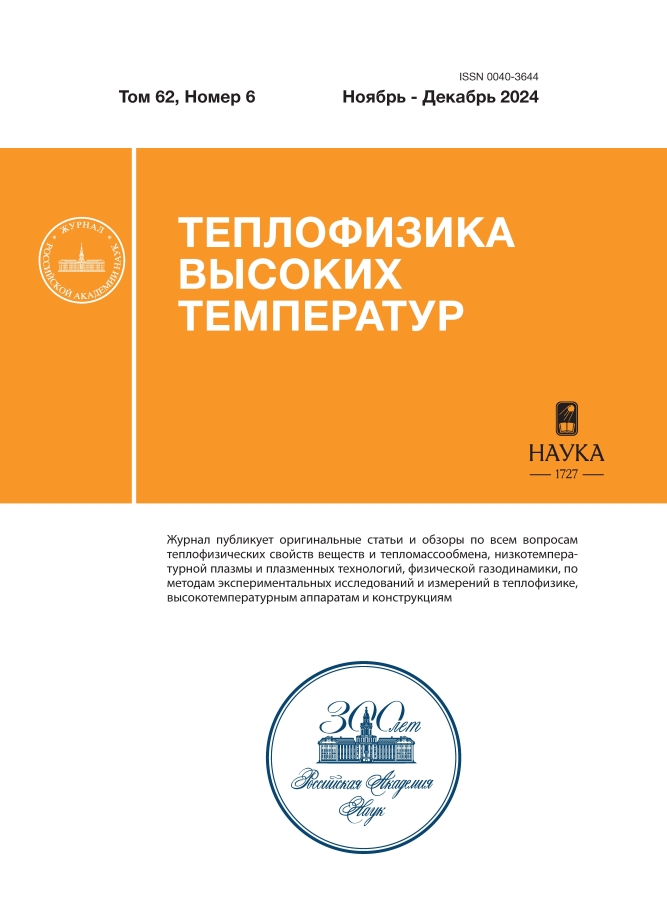Теплообмен при кипении в тонком слое диэлектрической жидкости HFE-7100 на капиллярно-пористых покрытиях
- Авторлар: Швецов Д.А.1, Павленко А.Н.1, Назаров А.Д.1, Михайлов А.В.1, Жуков В.И.1,2
-
Мекемелер:
- Институт теплофизики им. С.С. Кутателадзе СО РАН
- Новосибирский государственный технический университет
- Шығарылым: Том 62, № 6 (2024)
- Беттер: 865-876
- Бөлім: Heat and Mass Transfer and Physical Gasdynamics
- URL: https://bioethicsjournal.ru/0040-3644/article/view/683695
- DOI: https://doi.org/10.31857/S0040364424060088
- ID: 683695
Дәйексөз келтіру
Аннотация
В работе представлено экспериментальное исследование теплообмена при кипении на капиллярно-пористых покрытиях с различной теплопроводностью в горизонтальных слоях диэлектрической жидкости HFE-7100. Образцы покрытий из нержавеющей стали и из бронзы изготовлены с помощью аддитивной технологии 3D-печати методом селективного лазерного плавления/спекания. С помощью высокоскоростной термографической съемки исследованы механизмы интенсификации теплообмена при кипении и динамика развития кризисных явлений в тонком слое диэлектрической жидкости HFE-7100. Показано, что вследствие активации действующих центров парообразования большего диапазона размеров на капиллярно-пористом покрытии из нержавеющей стали достигается более высокая интенсификация теплообмена при кипении, чем на покрытии из бронзы. Установлено, что при развитии кризисных явлений скорость распространения границы фронта осушения вдоль каналов 2D модулированных капиллярно-пористых покрытий примерно в два раза больше, чем в поперечном направлении.
Толық мәтін
Авторлар туралы
Д. Швецов
Институт теплофизики им. С.С. Кутателадзе СО РАН
Хат алмасуға жауапты Автор.
Email: shvetsov.kh301@ya.ru
Ресей, Новосибирск
А. Павленко
Институт теплофизики им. С.С. Кутателадзе СО РАН
Email: shvetsov.kh301@ya.ru
Ресей, Новосибирск
А. Назаров
Институт теплофизики им. С.С. Кутателадзе СО РАН
Email: shvetsov.kh301@ya.ru
Ресей, Новосибирск
А. Михайлов
Институт теплофизики им. С.С. Кутателадзе СО РАН
Email: shvetsov.kh301@ya.ru
Ресей, Новосибирск
В. Жуков
Институт теплофизики им. С.С. Кутателадзе СО РАН; Новосибирский государственный технический университет
Email: shvetsov.kh301@ya.ru
Ресей, Новосибирск; Новосибирск
Әдебиет тізімі
- Leong K.C., Ho J.Y., Wong K.K. A Critical Review of Pool and Flow Boiling Heat Transfer of Dielectric Fluids on Enhanced Surfaces // Appl. Therm. Eng. 2017. V. 112. P. 999.
- Zhang C., Sun X., Han Z., Li X., Dong J. Energy Saving Potential Analysis of Twophase Immersion Cooling System with Multi-mode Condenser // Appl. Therm. Eng. 2023. V. 219. 119614.
- Васильев Н.В., Вараксин А.Ю., Зейгарник Ю.А., Ходаков К.А., Эпельфельд А.В. Характеристики кипения воды, недогретой до температуры насыщения, на структурированных поверхностях // ТВТ. 2017. Т. 55. № 6. С. 712.
- Дедов А.В., Забиров А.Р., Слива А.П., Федорович С.Д., Ягов В.В. Влияние углеродистого покрытия поверхности на теплообмен при нестационарном пленочном кипении // ТВТ. 2019. T. 57. № 1. С. 72.
- Aksyanov R.A., Kokhanova Y.S., Kuimov E.S., Gortyshov Y.F., Popov I.A. Recommendations for Improving the Efficiency of Radio-Electronic Equipment Cooling Systems //Russ. Aeronautics. 2021. V. 64. P. 291.
- Chinnov E.A., Khmel S.Ya., Vladimirov V.Yu., Safonov A.I., Semionov V.V., Emelyanenko K.A., Emelyanenko A.M., Boinovich L.B. Boiling Heat Transfer Enhancement on Biphilic Surfaces // Energies. 2022. V. 15. № 19. P. 7296.
- Dedov A.V., Khaziev I.A., Laharev D.A., Fedoro-vich S.D. Study of Nucleate Pool Boiling Heat Transfer Enhancement on Surfaces Modified by Beam Technologies // Heat Transfer Eng. 2022. V. 43. № 7. P. 598.
- Kuzma-Kichta Y.A., Ivanov N.S., Lavrikov A.V., Chugunkov D.V. Intensification of Heat Transfer During Boiling and Condensation by Means of Micro- and Nanoparticle Coatings //J. Eng. Phys. Thermophys. 2023. V. 96. P. 345.
- Gao B., Zhao H., Peng L., Sun Z. A Review of Research Progress in Selective Laser Melting (SLM) // Micromachines. 2022. V. 14. № 1. P. 57.
- Alvariño P.F., Simón M.L.S., dos Santos Guzella M., Paz J.M.A., Jabardo J.M.S., Gómez L.C. Experimental Investigation of the CHF of HFE-7100 under Pool Boiling Conditions onDifferently Roughened Surfaces // Int. J. Heat Mass Transfer. 2019. V. 139. P. 269.
- Fan X., Gu S., Lei J., Luo G., Meng F., Wu L., Gu S. Experimental and Analytical Study on the Influence of Saturation Pressure and Surface Roughness on Pool Boiling CHF of HFE-7100 // Int. J. Chem. Eng. 2022. V. 2022. https://doi.org/10.1155/2022/4875208
- Zhukov V.I., Pavlenko A.N., Shvetsov D.A. The Effect of Pressure on Heat Transfer at Evaporation/Boiling in Horizontal Liquid Layers of Various Heights on a Microstructured Surface Produced by 3D Laser Printing // Int. J. Heat Mass Transfer. 2020. V. 163. 120488.
- Ярышев Н.А. Теоретические основы измерения нестационарной температуры. 2-е изд., перераб. Л.: Энергоатомиздат, 1990. 255 c.
- Олейник Б.П., Сурин В.Г., Петрова О.К. Исследование теплопроводности нержавеющей и низкоуглеродистой сталей // ТВТ. 1985. Т. 23. № 3. C. 500.
- Станкус С.В., Савченко И.В., Багинский А.В., Верба О.И., Прокопьев А.М., Хайрулин Р.А. Коэффициент теплопроводности нержавеющей стали 12Х18Н10Т в широком интервале температур // ТВТ. 2008. Т. 46. № 5. С. 795.
- Бессмельцев В.П., Павленко А.Н., Жуков В.И. Разработка технологии создания структурированных капиллярно-пористых покрытий методом 3D-печати для интенсификации теплообмена при кипении // Автометрия. 2019. Т. 55. № 6. С. 25.
- Зубченко А.С., Колосков М.М., Каширский Ю.В. и др. Марочник сталей и сплавов. 2-е изд., доп. и испр. / Под ред. Зубченко А.С. М.: Машиностроение, 2003. 784 с.
- Осинцев О.Е., Федоров В.Н. Медь и медные сплавы. Отечественные и зарубежные марки. Спр. М.: Машиностроение, 2004. 336 с.
- Кутателадзе С.С. Гидромеханическая модель кризиса теплообмена в кипящей жидкости при свободной конвекции // ЖТФ. 1950. Т. 20. № 11. С. 1389.
- Yagov V.V. Is a Crisis in Pool Boiling Actually a Hydrodynamic Phenomenon? // Int. J. Heat Mass Transfer. 2014. V. 73. P. 265.
- Shvetsov D.A., Pavlenko A.N., Brester A.E., Zhukov V.I. Experimental Study of Heat Transfer During Boiling in a Thin Layer of Liquid on Surfaces with Structured Porous Coatings // J. Phys.: Conf. Ser. 2021. V. 2119. № 1. 012082.
- Bodla K.K., Murthy J.Y., Garimella S.V. Direct Simulation of Thermal Transport Through Sintered Wick Microstructures // J. Heat Transfer. 2012. V. 134. 012602.
Қосымша файлдар






















